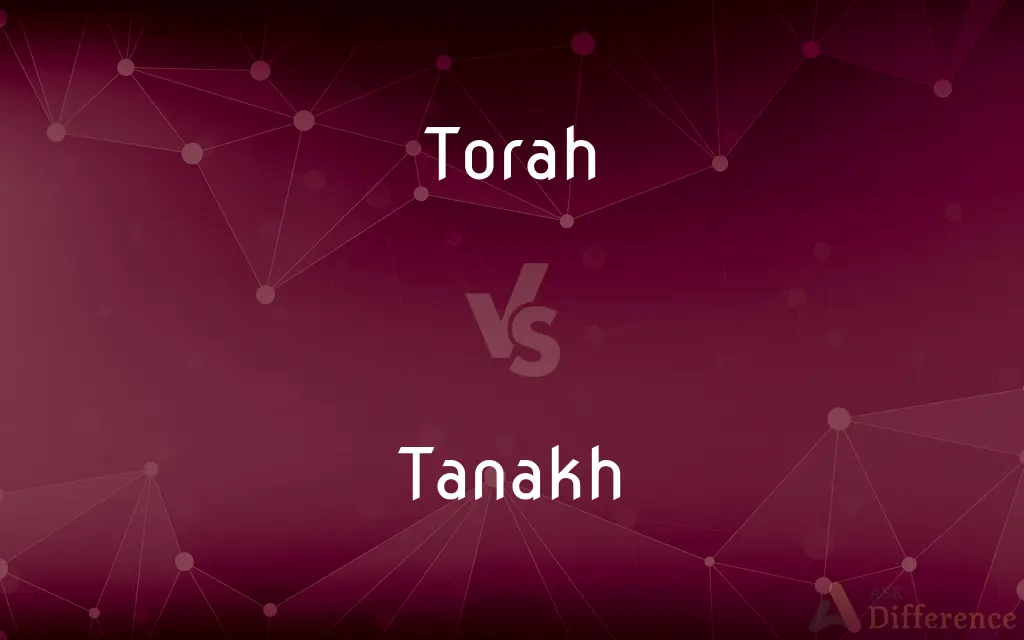Torah vs. Tanakh — What's the Difference?
By Tayyaba Rehman — Updated on October 31, 2023
Torah is the foundational Jewish scripture containing laws and teachings, forming the first part of the Tanakh, which includes prophets and writings.

Difference Between Torah and Tanakh
Table of Contents
ADVERTISEMENT
Key Differences
The Torah is the central reference of the Jewish religion, comprising the first five books of the Hebrew Bible. It is considered the written law, containing narratives, commandments, and teachings. On the other hand, the Tanakh is a term for the entire Hebrew Bible, encompassing the Torah, the Nevi'im (Prophets), and the Ketuvim (Writings). While the Torah is foundational, the Tanakh provides a broader spectrum of Jewish religious literature.
The Torah, also known as the Pentateuch, includes the books of Genesis, Exodus, Leviticus, Numbers, and Deuteronomy. These books narrate the creation of the world, the history of the Israelites, and God's laws. In contrast, the Tanakh is a collection of 24 books, extending beyond the Torah to include historical accounts, poetic writings, and prophetic messages. The Tanakh is divided into three sections, with the Torah being just one of them.
In terms of use, the Torah holds a special place in Jewish liturgy and rituals. It is read in synagogues on a weekly basis, with its verses and teachings being central to Jewish religious life. The Tanakh, while revered and studied, encompasses a wider range of texts, including historical narratives and poetic books like Psalms, which play different roles in Jewish thought and practice.
The Torah is traditionally believed to have been given to Moses by God at Mount Sinai. This divine origin gives the Torah its unique status and authority. The Tanakh, while also considered sacred, is seen as a broader compilation of texts, some of which were written over several centuries by different authors. The Torah forms the core, but the Tanakh provides a comprehensive religious and historical framework.
The language and style of writing also distinguish the Torah from the Tanakh. The Torah predominantly contains laws and narrative history, written in a style that reflects its ancient origins. The Tanakh, however, encompasses a variety of literary genres, including poetry, prophecy, and wisdom literature, reflecting the diverse authors and contexts of its books.
ADVERTISEMENT
Comparison Chart
Composition
First 5 books of Hebrew Bible
Entire Hebrew Bible (24 books)
Sections
Single section
Three sections: Torah, Nevi'im, Ketuvim
Content Type
Laws, narratives
Laws, narratives, prophecies, writings
Role in Judaism
Central, read weekly in synagogue
Broader study, different roles in practice
Authorship
Traditionally from Moses
Various authors, over centuries
Compare with Definitions
Torah
The Torah is the foundational religious text of Judaism.
The Rabbi explained a passage from the Torah during the service.
Tanakh
The Tanakh is the complete Hebrew Bible.
She referenced a verse from the Tanakh during the discussion.
Torah
Torah is a term used for the written law in Jewish tradition.
He read from the Torah during his Bar Mitzvah.
Tanakh
Tanakh includes Torah, Prophets, and Writings.
The story of King David is found in the Tanakh.
Torah
Torah encompasses the laws and teachings given to Moses.
The Torah's teachings continue to guide Jewish life and ethics.
Tanakh
Tanakh is a key religious text in Judaism.
The Tanakh's teachings are diverse, covering laws and poetry.
Torah
Torah is a central component of Jewish religious practice.
The synagogue keeps a Torah scroll in the ark.
Tanakh
Tanakh encompasses a broad range of Jewish literature.
Wisdom from the Tanakh often guides moral decisions.
Torah
Torah (; Hebrew: תּוֹרָה, "Instruction", "Teaching" or "Law") has a range of meanings. It can most specifically mean the first five books (Pentateuch or Five Books of Moses) of the Hebrew Bible, namely (in their commonly used names) Genesis, Exodus, Leviticus, Numbers and Deuteronomy.
Tanakh
Tanakh is a term for the canonical collection of Jewish texts.
Scholars study the Tanakh to understand Jewish history.
Torah
The first five books of the Hebrew Scriptures. See Table at Bible.
Tanakh
See Hebrew Scriptures.
Torah
A scroll of parchment containing the first five books of the Hebrew Scriptures, used in a synagogue during services.
Tanakh
The Jewish scriptures which consist of three divisions--the Torah and the Prophets and the Writings
Torah
The entire body of religious law and learning including both sacred literature and oral tradition.
Torah
A law; a precept.
A considerable body of priestly Toroth.
Torah
Divine instruction; revelation.
Tora, . . . before the time of Malachi, is generally used of the revelations of God's will made through the prophets.
Torah
The Pentateuch or "Law of Moses."
The Hebrew Bible is divided into three parts: (1) The Torah, "Law," or Pentateuch. (2) The Prophets (Nevi'im in Hebrew) . . . (3) The Kethubim, or the "Writings," generally termed Hagiographa. From the first letters of these three parts, the word "Tanakh" is derived, and used by Jews as the name of their Bible, the Christian Old Testament.
Torah
The whole body of the Jewish sacred writings and tradition including the oral tradition
Torah
The first of three divisions of the Hebrew Scriptures comprising the first five books of the Hebrew Bible considered as a unit
Torah
(Judaism) the scroll of parchment on which the first five books of the Hebrew Scripture is written; is used in a synagogue during services
Torah
Torah refers to the first five books of the Hebrew Bible.
Students were studying the creation story from the Torah.
Common Curiosities
How many books are in the Torah?
Genesis, Exodus, Leviticus, Numbers, and Deuteronomy.
How many books are in the Tanakh?
The Tanakh is made up of 24 books.
What is the Tanakh?
The Tanakh is the canonical collection of Jewish texts, including the Torah, Prophets (Nevi'im), and Writings (Ketuvim).
Who wrote the Tanakh?
The Tanakh was written by various authors over centuries.
What is the Torah?
The Torah is the central reference of Jewish religious law and theology, comprising the first five books of the Hebrew Bible.
How is the Torah used in Jewish life?
The Torah is read weekly in synagogues and serves as the basis for Jewish law and ethics.
Is the Torah the same as the Old Testament?
The Torah corresponds to the first five books of the Old Testament but is not synonymous with it.
Is the Tanakh the same as the Old Testament?
The Tanakh and the Old Testament have similar texts but differ in order, language, and interpretation.
Who wrote the Torah?
Traditional Jewish belief attributes the authorship of the Torah to Moses.
What language is the Tanakh written in?
The Tanakh is primarily written in Biblical Hebrew, with some portions in Aramaic.
How is the Tanakh used in Jewish study?
The Tanakh is studied for religious guidance, historical understanding, and literary appreciation.
What language is the Torah written in?
The Torah is written in Biblical Hebrew.
Does the Tanakh include the New Testament?
No, the Tanakh does not include the New Testament; it is a Jewish text.
How do Torah and Tanakh differ in content?
The Torah contains laws and narratives, while the Tanakh includes a broader range of texts, including prophecies and writings.
Are the teachings of the Torah still relevant today?
Yes, the teachings of the Torah continue to guide Jewish religious practice and ethics.
Share Your Discovery

Previous Comparison
Tea vs. Coffee
Next Comparison
Alcohol vs. EthanolAuthor Spotlight
Written by
Tayyaba RehmanTayyaba Rehman is a distinguished writer, currently serving as a primary contributor to askdifference.com. As a researcher in semantics and etymology, Tayyaba's passion for the complexity of languages and their distinctions has found a perfect home on the platform. Tayyaba delves into the intricacies of language, distinguishing between commonly confused words and phrases, thereby providing clarity for readers worldwide.














































